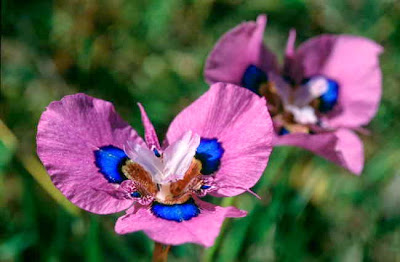Type of Flower
Moraea villosa:
Moraea villosa is a species of peacock moraea, a group of plants named for the large, conspicuous eye-like patterns on the broad outer petals of the flowers.
Moraea villosa is found on stony granite and clay slopes and flats in the winter rainfall area of western South Africa. Most commonly, the flowers are pale purple with a large blue nectar guide and a hairy center colored either yellow or orange.Flowering in Northern California and grown from seed.
Moraea villosa subsp. villosa is classified as Vulnerable due to its restricted range, few remaining populations and declining habitat. Although a few large populations of several thousand plants remain, most populations consist of only a few plants confined to small, isolated habitat fragments. Populations on these small fragments, which are surrounded by crop fields, are threatened by a lack of fire (which stimulates flowering), loss of pollinators, pollution by pesticides and fertilizer, and invasion by alien plants, particularly grasses, which find favourable habitat in the fertilizer-enriched soil.
Moraea villosa subsp. elandsmontana is also classified as Vulnerable, due to its small population size. Only one population of about 350 plants is known. This population is protected in the Elandsberg Private Nature Reserve, and is not otherwise affected by any threats.
Moraea villosa is named for its hairy stems and leaves (villous meaning hairy or shaggy), the distinguishing feature of this species. It was discovered between 1772 and 1775 by the Swedish botanist Carl Peter Thunberg, a student of Linnaeus who is often called ‘the father of Cape botany' (Gunn & Codd 1981). Thunberg was one of the first European botanists to explore the Cape Flora, and during his three years at the Cape discovered more than 3000 new plant species.
Subsp. elandsmontana was discovered by the botanical artist Fay Anderson in 1979. The painting of her discovery can be seen in the illustrated monograph of the genus by Peter Goldblatt (Goldblatt 1986).
Moraea villosa is easy to grow, and will make an attractive plant in a small garden or pot. Plants can be grown from either seeds or corms. Seeds germinate easily, but plants grown from seed may take up to two or three years to flower. Seeds or corms should be planted in well-drained soil in late March or April. Plant corms two to three times as deep as their diameter. Water sparingly, and avoid over-use of fertilizer. At the end of the flowering season, lift corms to prevent insect damage and rotting.
References
http://www.plantzafrica.com/plantklm/moraeavillosa.htm http://www.pacificbulbsociety.org/pbswiki/index.php/MoraeaSpeciesTen#villosa




































